Learn how to make pasta at home! This 4-ingredient homemade pasta recipe is easy to make, and it yields chewy, delicious noodles every time.
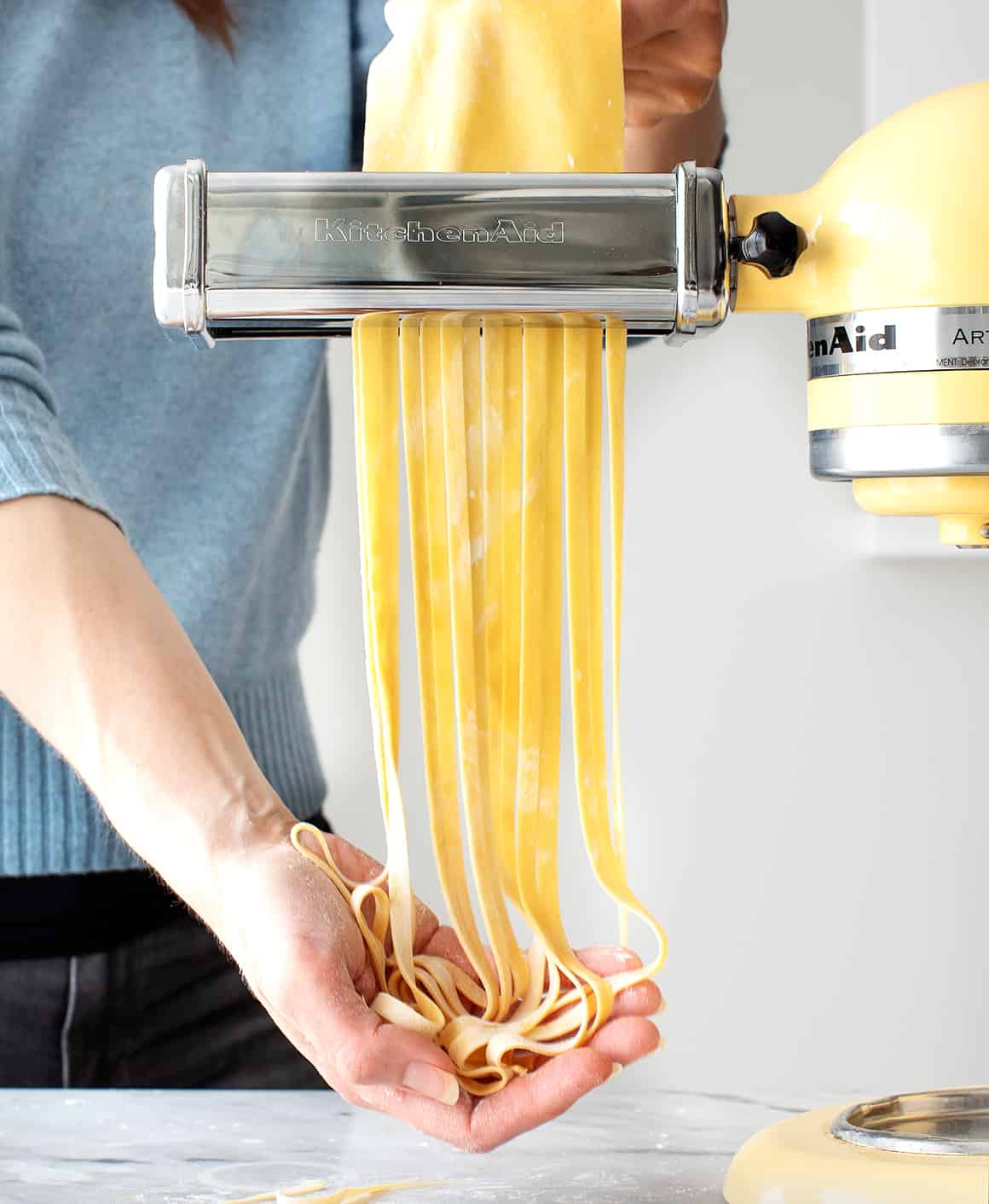
This homemade pasta recipe is our new favorite cooking project! Lately, Jack and I have been spending even more time than usual in the kitchen, experimenting with bread, baked goods, and even okonomiyaki. But we keep coming back to homemade pasta. It’s super fun to make together, and it only requires a handful of basic ingredients. Of course, the fact that it’s absolutely delicious doesn’t hurt either. 🙂
My homemade pasta recipe refers to the pasta maker attachment for the KitchenAid Stand Mixer, which is how we roll out our fresh pasta at home. If you don’t have a KitchenAid, don’t worry! You could also roll out this pasta dough according to the instructions on a regular pasta maker. However you make it, I hope you try this recipe. It’s an easy, fun way to spend an hour in the kitchen with someone you love, and at the end, you get to eat a big plate of chewy noodles with a perfect al dente bite.

Homemade Pasta Recipe Ingredients
You only need 4 ingredients to make delicious fresh pasta at home, and there’s a good chance you have all of them on hand already:
- All-purpose flour – In the past, I thought you needed 00 flour or semolina flour to make great fresh pasta, but this homemade pasta recipe proved me wrong. In it, regular all-purpose flour yields chewy, bouncy noodles every time.
- Eggs – The key ingredient for adding richness and moisture to the dough!
- Olive oil – Along with the eggs, a splash of olive oil moistens the dough and helps it come together.
- Salt – Add it to the dough and the pasta water for the best flavor.
Find the complete recipe with measurements below.

How to Make Pasta
Ready to learn how to make pasta? Check out this step-by-step guide first, and then find the full recipe at the bottom of this post!
First, make a nest with the flour on a clean work surface. Add the remaining ingredients to the center and use a fork to gently break up the eggs. Try to keep the flour walls intact as best as you can!
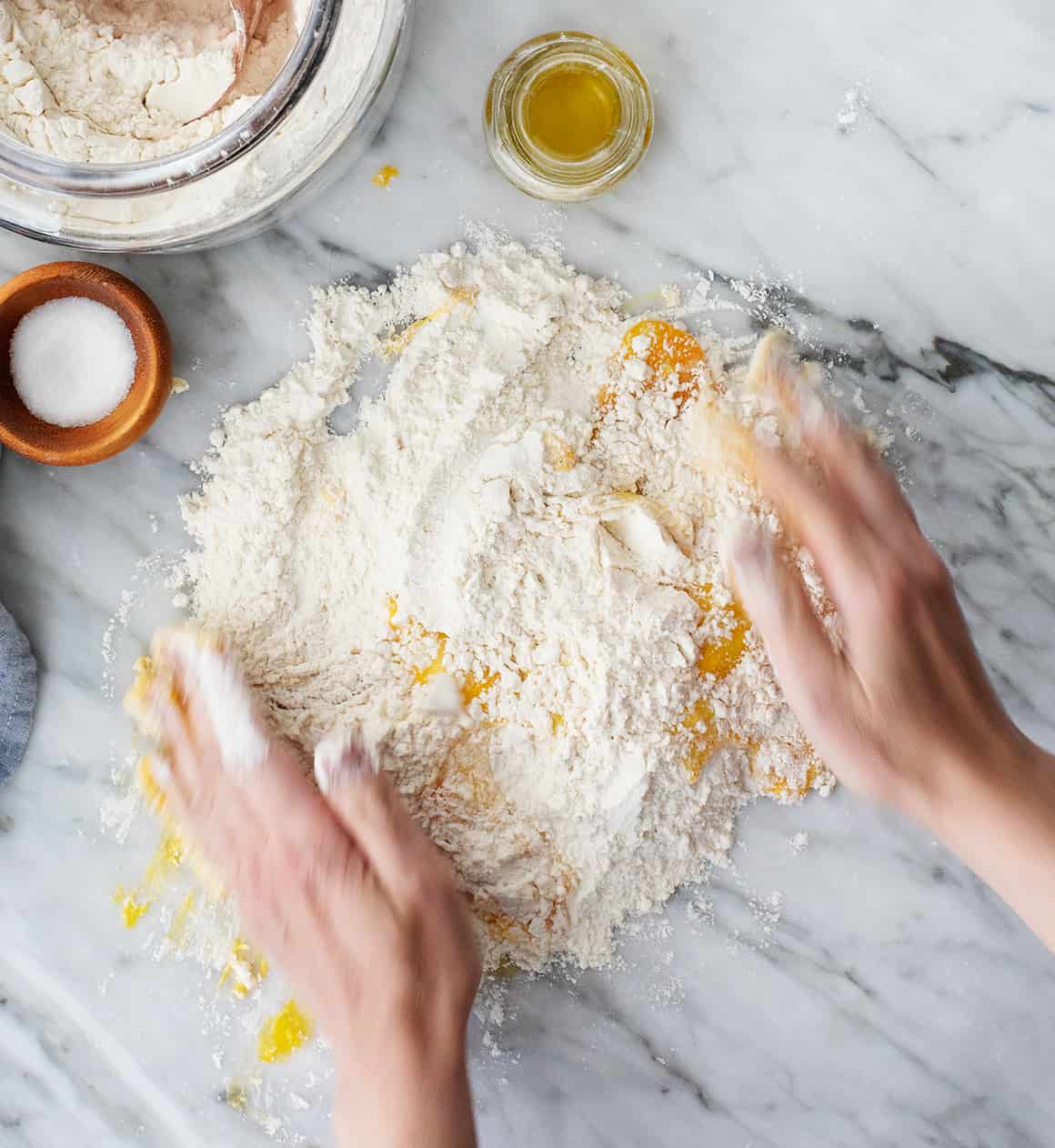
Next, use your hands to gently mix in the flour. Continue working the dough to bring it together into a shaggy ball.
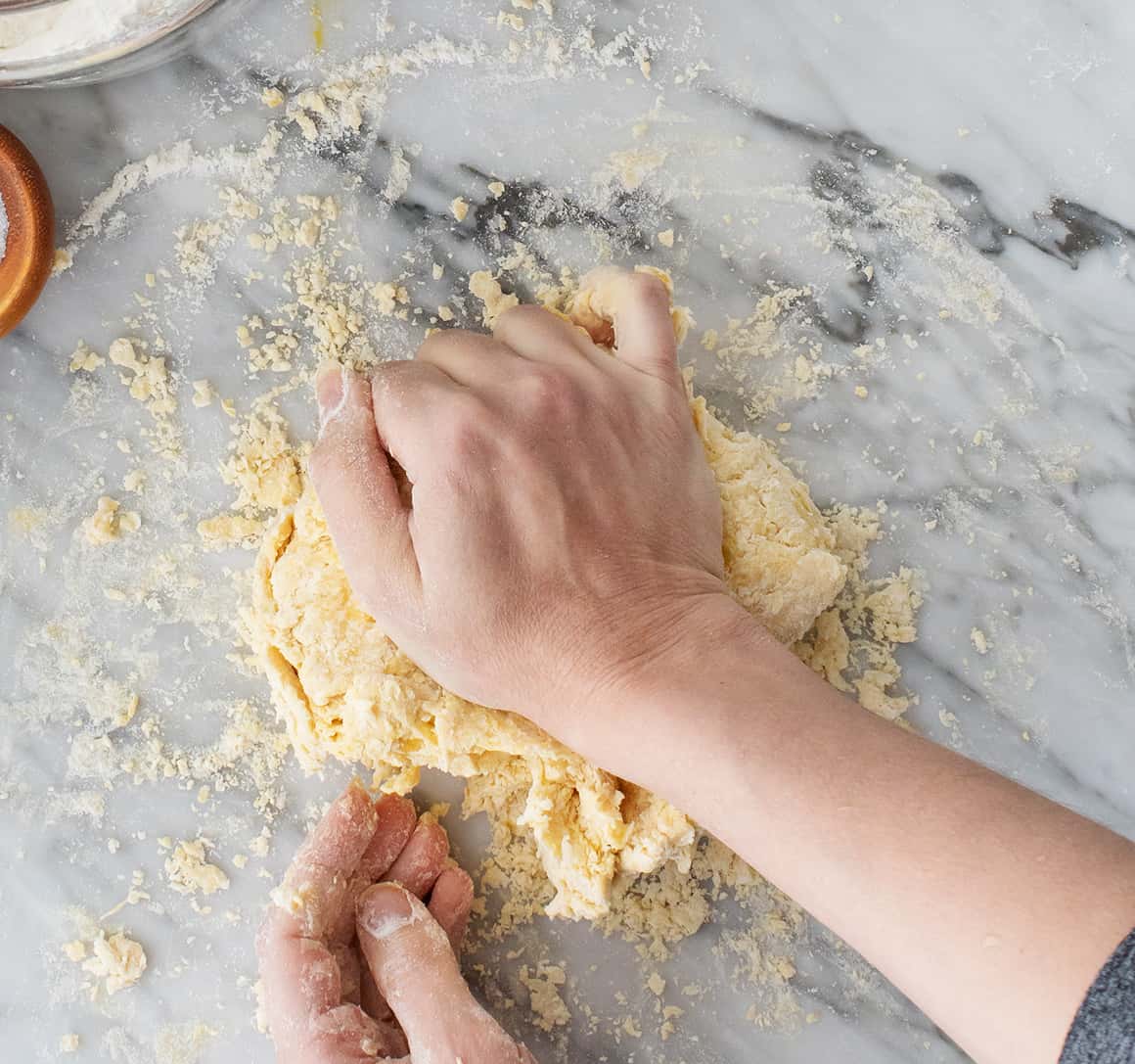
Then, knead! At the beginning, the dough should feel pretty dry, but stick with it! It might not feel like it’s going to come together, but after 8-10 minutes of kneading, it should become cohesive and smooth:

If the dough still seems too dry, sprinkle your fingers with water and continue kneading to incorporate it into the dough. If the dough becomes too sticky, dust more flour onto your work surface.
When the dough comes together, shape it into a ball and wrap it in plastic wrap. Let the dough rest at room temperature for 30 minutes.
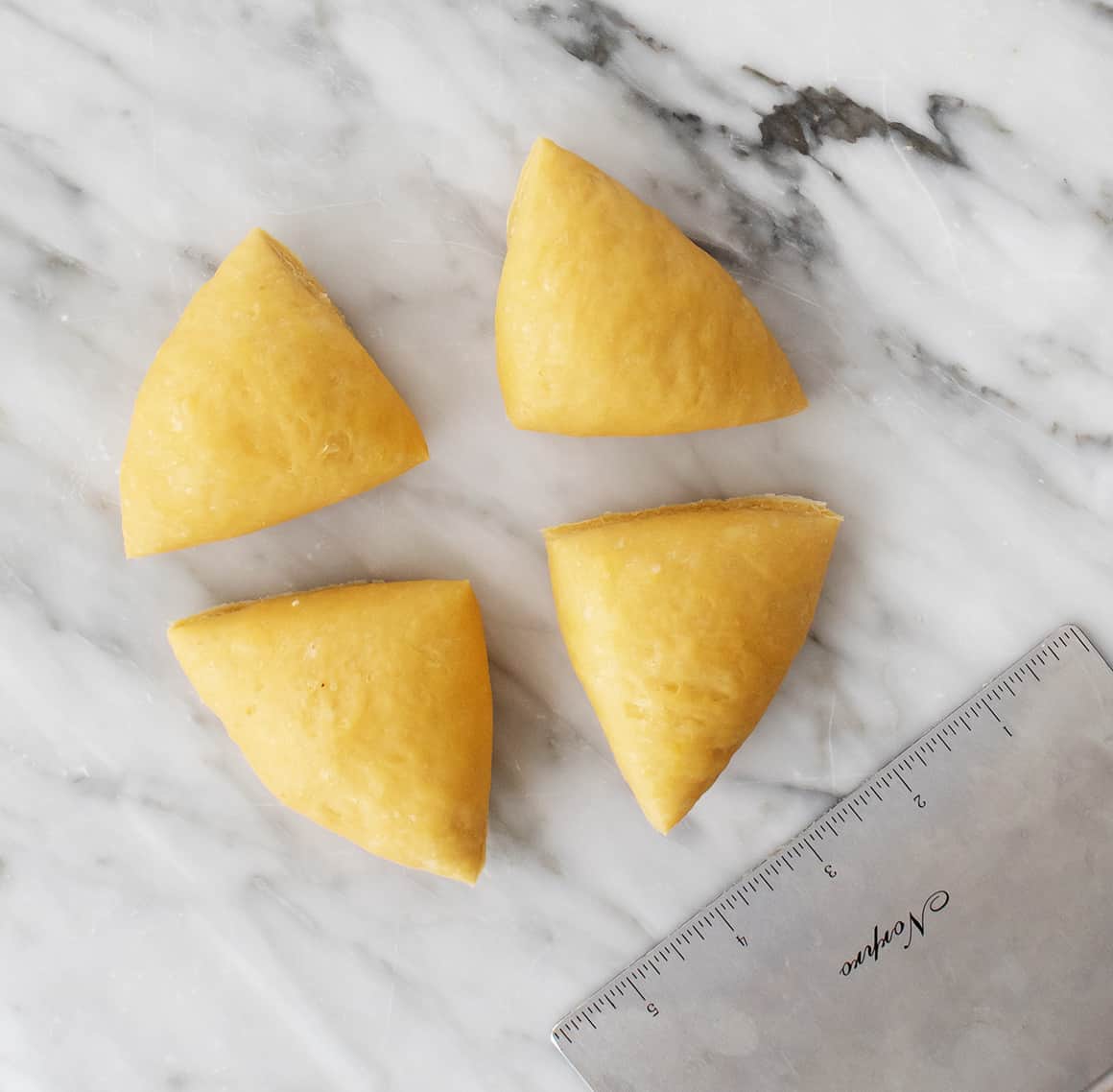
After the dough rests, slice it into 4 pieces.
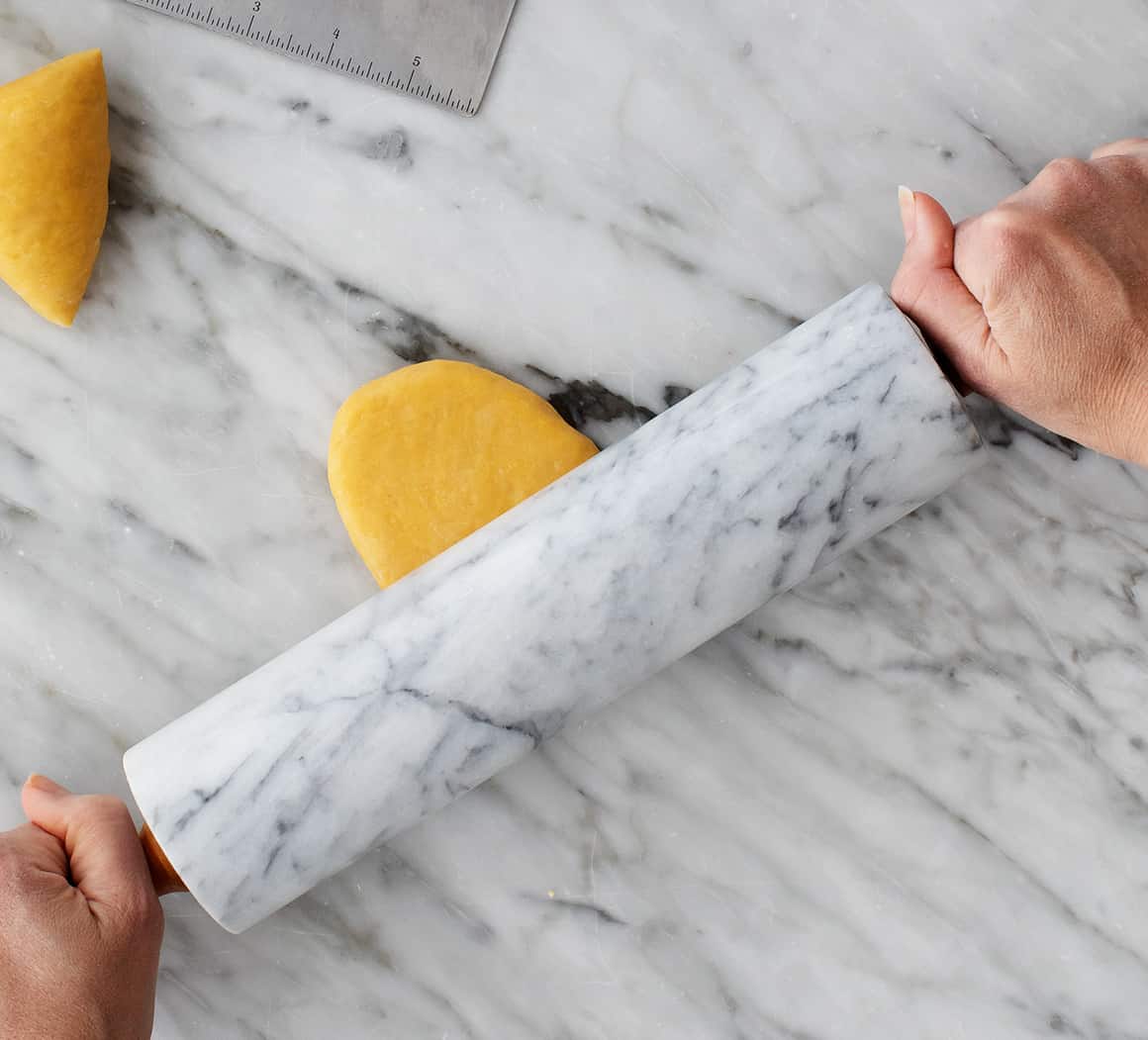
Use a rolling pin or your hands to gently flatten one into an oval disk.

Then, run it through the widest setting of your pasta maker (level 1 on the KitchenAid attachment). I run the dough through the pasta maker 3 times on this setting before proceeding to the next step. If you don’t have the KitchenAid attachment, roll out the dough according to your pasta maker’s instructions.

Next, fold the dough… if you want to. This step is somewhat optional, but it will make your final pasta sheet more rectangular, which will yield more long strands of pasta. Plus, it’s super simple! Just lay the dough flat and fold both short ends in to meet in the center.

Then, fold it in half lengthwise to form a rectangle.

Once you’ve folded the dough, roll it out to your desired thickness. On my KitchenAid attachment, I run it through the pasta roller three times on level 2, three times on level 3, and one time each on levels 4, 5, and 6.
Repeat these steps with the remaining dough pieces. Each time you finish with a piece of dough, lay one half of it on a lightly floured baking sheet. Sprinkle the dough with flour, and fold the other half on top. Sprinkle the top with flour, too!
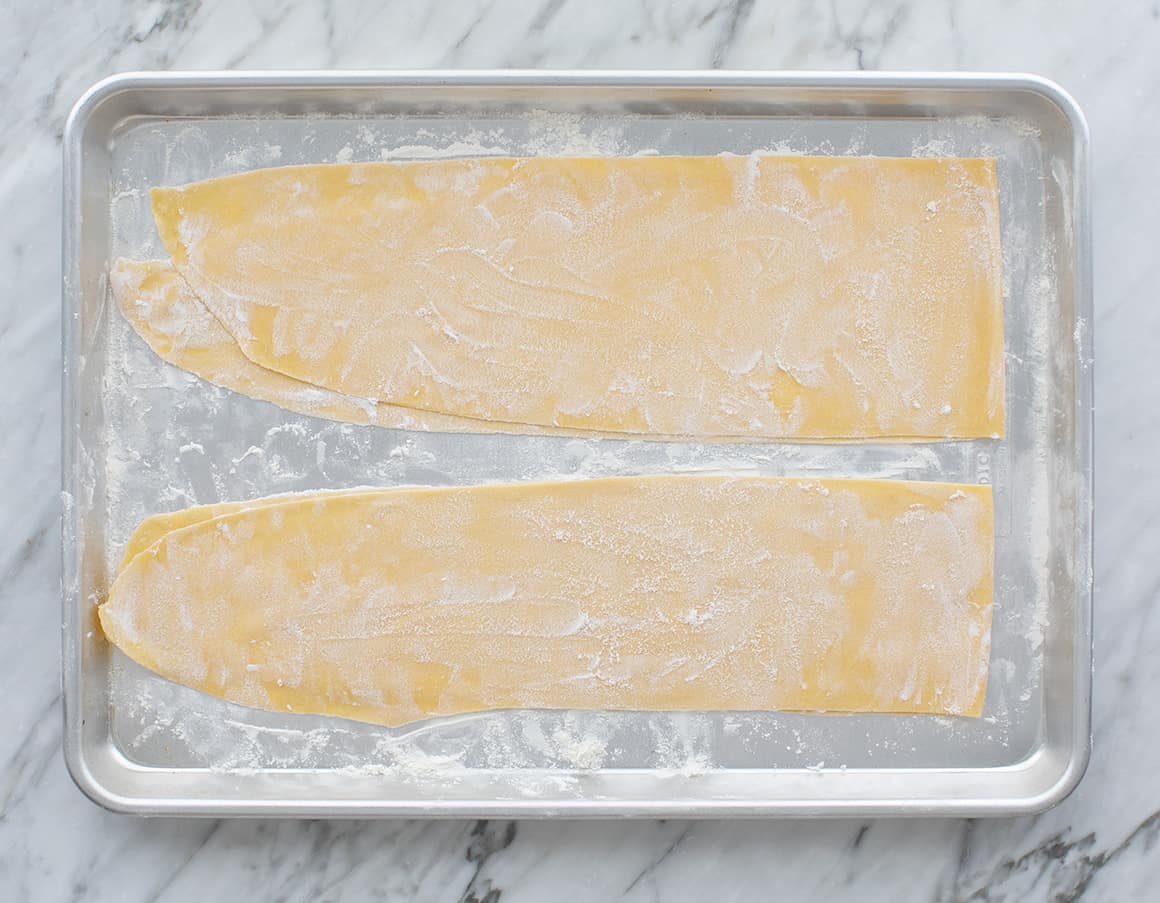
Finally, cut and cook the pasta. Run the pasta sheets through your desired pasta cutter attachment. Cook the noodles in a pot of boiling salted water for 1 minute, and enjoy!
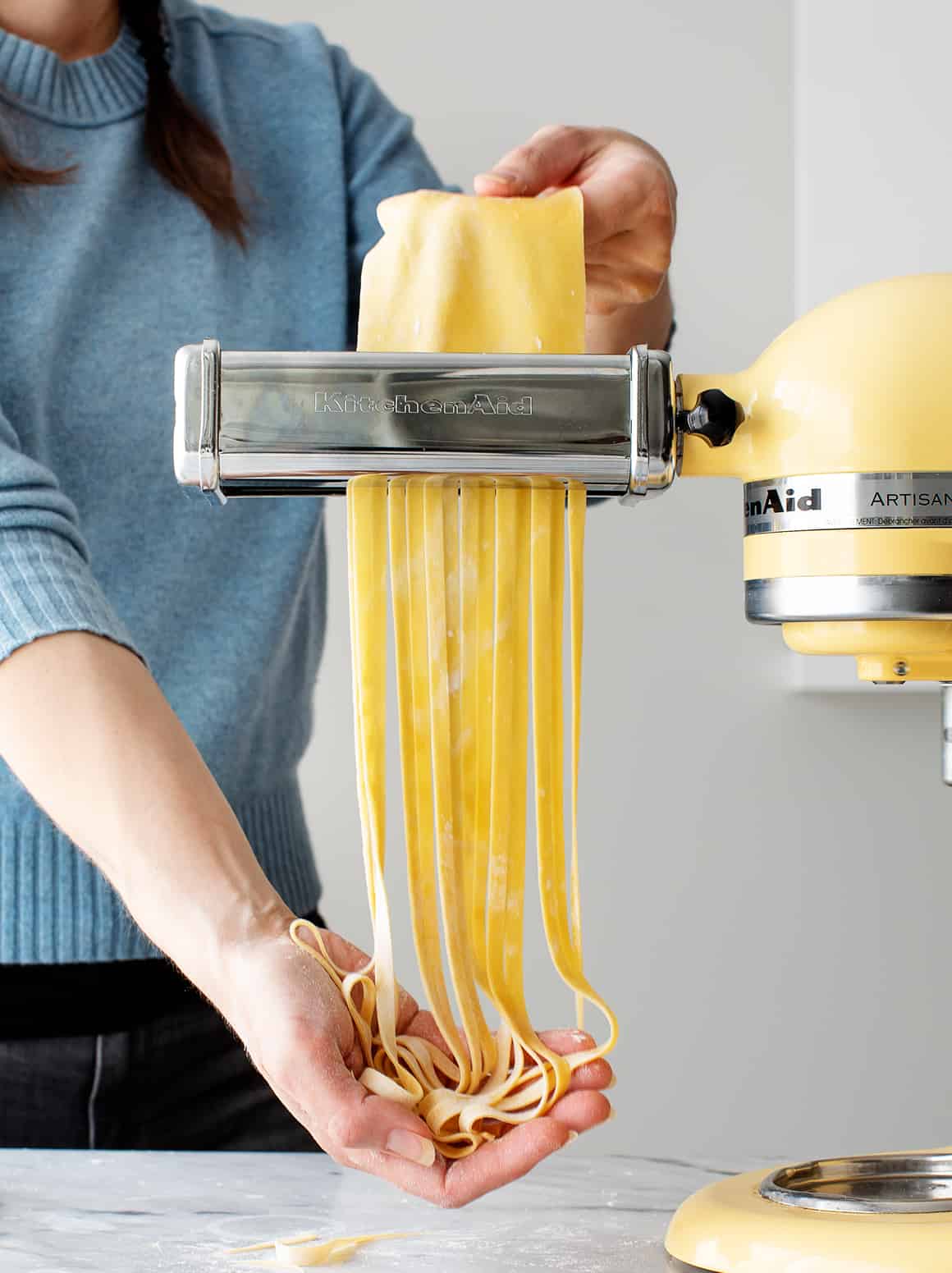
Homemade Pasta Serving Suggestions
If you’ve never had fresh pasta before, you’re in for a treat! Its chewy, bouncy texture and rich flavor make it so much better than the dried pasta at the store. In fact, these noodles are so good that we usually serve them really simply. They’re fantastic with marinara sauce, pesto, homemade Alfredo sauce, or olive oil and vegan Parmesan or Parmesan cheese.
Of course, they’re delicious in larger pasta dishes, too. Use them instead of dried pasta in any of these recipes:
- Tagliatelle with Asparagus & Peas
- Spaghetti Aglio e Olio
- Fettuccine Alfredo
- Easy Pesto Pasta
- Roasted Vegetable Pasta
- Linguine with Lemon and Tomatoes
- Garlic Herb Mushroom Pasta
Find more of my favorite pasta recipes here!


Homemade Pasta
Equipment
- KitchenAid Mixer (the stand mixer to use the pasta attachment)
- Pasta Attachment (my favorite KitchenAid attachment!)
- Baking Sheets (I use these nonstick ones from Nordic Ware)
Ingredients
- 2 cups all-purpose flour, spooned & leveled
- 3 large eggs
- ½ teaspoon sea salt
- ½ tablespoon extra-virgin olive oil
Instructions
- Place the flour on a clean work surface and make a nest. Add the eggs, olive oil, and salt to the center and use a fork to gently break up the eggs, keeping the flour walls intact as best as you can. Use your hands to gently bring the flour inward to incorporate. Continue working the dough with your hands to bring it together into a shaggy ball.
- Knead the dough for 8 to 10 minutes. At the beginning, the dough should feel pretty dry, but stick with it! It might not feel like it’s going to come together, but after 8-10 minutes of kneading, it should become cohesive and smooth. If the dough still seems too dry, sprinkle your fingers with a tiny bit of water to incorporate. If it’s too sticky, dust more flour onto your work surface. Shape the dough into a ball, wrap in plastic wrap, and let rest at room temperature for 30 minutes.
- Dust 2 large baking sheets with flour and set aside.
- Slice the dough into four pieces. Gently flatten one into an oval disk. Run the dough through the Pasta Roller Attachment or a pasta maker three times on level 1 (the widest setting).
- Set the dough piece onto a countertop or work surface. Fold both short ends in to meet in the center, then fold the dough in half to form a rectangle (see photo above).
- Run the dough through the pasta roller three times on level 2, three times on level 3, and one time each on levels 4, 5, and 6.
- Lay half of the pasta sheet onto the floured baking sheet and sprinkle with flour before folding the other half on top. Sprinkle more flour on top of the second half. Every side should be floured so that your final pasta noodles won't stick together.
- Repeat with remaining dough.
- Run the pasta sheets through the Pasta Cutter Attachment (pictured is the fettuccine cutter). Repeat with remaining dough. Cook the pasta in a pot of salted boiling water for 1 to 2 minutes.
Notes
adapted from Serious Eats








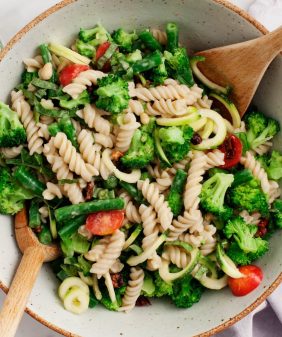





Keeper recipe! My 1st attempt at making pasta with my new Kitchen Aid Pasta Attachment. Easy to follow recipe. Simple ingredients. Delicious results! Loved the texture of the pasta. Thank you!
I’m so glad your pasta turned out well!
This recipe was fantastic! I’ve always used 00 flour for my fresh pasta, so wanted to give it a try with what I had on hand at home. I was worried they’d come out a little tough, but I had beautiful, delicate fettuccine noodles that were perfect! My 8 year old daughter and I made this together and she already wants to make it again:) Thank you!
I’m so glad you both enjoyed the recipe!
Love this pasta recipe with my hack. If you want veggie flavored pasta (spinach, carrot, pea, etc) just mix in a jar of pureed baby food it saves time and is easier than dealing with fresh.
Hi Michael, thanks for the hack!
Any particular reason why one couldn’t use the dough hook to mix the dough? I mean why would I be hand kneading when I’ve spent ~$600 on this mixer?
Hi Eric, it’s a very stiff dough and it’s easier to work by hand. I don’t think it forms well around the dough hook like other doughs do (pizza dough, bagel dough, pretzel dough, etc). Some others in the comments have had success with the dough hook, it’s just not what I prefer.
How much pasta is this equivalent to when buying store bought? Such as, does it make the same amount as a 1lb box of store bought?
Just got my pasta attachments for Christmas for my KitchenAid and was excited to use it. Pasta turned out perfect and will be my go to recipe!
I’m so glad your pasta turned out well!
I’m teaching my 14 year old granddaughter Home Economics and we made the pasta. My 5 year old grand daughter also participated. We had so much fun. Our first rollout was too thin like linguini. So we adjusted the rolls and our spaghetti was perfect! This recipe is easy n fun!
Hi Charmaine, I’m so glad you enjoyed making the pasta with her!
Do you fold it after completing each level (ie, fold between 1-2, 2-3, etc)?
Hi Natalie, no just after the first level.
Made this today to serve with beef stroganoff as I forgot noodles at the store. Super easy recipe and tasted great. I left the noodles a bit thicker (a five on my kitchenaid attachment) so the noodles would hold up to the heaviness of the beef topping. They worked great, and I will def make again!
I’m trying this tonight. Do you if you could store it so it would keep longer?
Hi Brittany, I haven’t stored it long, so I’m not sure. For the effort, I usually just cook it fresh.
we make pasta all the time, have for years – you can store it overnight, the noodles might just be q little more chewy the next day. we never keep it longer than that. hope this helps!
This was my first time making pasta ever. These instructions made it so easy and it was so delicious!! So happy I found it! Thanks 🙂
I’m so glad you enjoyed it!
Thank you! I’ve never made pasta before and found this so easy to follow. I totally impressed myself with the meal I made.
I’m so glad the recipe worked well for you!
I made this dough recipe in my kitchen aid mixer with the dough hook for 10 min on med speed. I had to add more flour, surprisingly started a little too wet, but very easy recipe to adjust, just added flour until the dough formed a ball and stopped sticking to the bowl. Let it rest, then also used the kitchen aid pasta roller. It was my first time making pasta and turned out amazing! Thank you for this recipe!
Did you break apart the eggs first and gently add flour with hands first? Before putting it in your Kitchenaid mixer with dough hook.
So on my kitchen aid. Level 1 is not widest. Level 8 is. So be careful and check or you will mess up the thickness.
This is truly the EASIEST pasta recipe. I’ve made no less than 10 times and it’s always delicious – thank you!
oh my gosh thank you so so so so much, I just had a great meal thanks to these easy instructions.
I’m so glad you loved the pasta!
Just got the KitchenAid attachments and found your recipe. First time making homemade pasta. Thank you for the fantastic recipe and step by step instructions! Made homemade Alfredo and the dish was amazing. This will be going into my recipe book!
I’m so glad your pasta worked out well!
This is the first pasta dough recipe I’ve tried that wasn’t a messy nightmare, and the noodles were great
I’m so glad you loved it!
I can’t remember if I commented before. This is exactly the same recipe as the one my grandmother brought with her from Sicily in 189090. We didn’t have actual amounts until the mid ‘70’s. It never fails!
Humidity levels definitely play a role, if you need more moisture, it’s best to wet your hands and knead the dough again….and resting it is important.
can i make the pasta the day before and let it sit out to dry ?
In preparing for a family surprise party, I experimented by preparing fettuccine using your recipe and it came out exactly as you described… tasty, chewy, with an al-dente bite. Fantastic!!! I don’t want the final product to change however I will need to prepare 3 times the amount. Can I just prepare one large batch or should I prepare three separate batches? Also, in order to maintain the same exact texture as cooking fettuccine immediately after preparing, do I need to always cook them immediately or can I prepare the noodles in the morning and refrigerate until dinner time? If I can refrigerate would you please tell me the exact procedure to follow. Thank you very much again for your time and expertise.